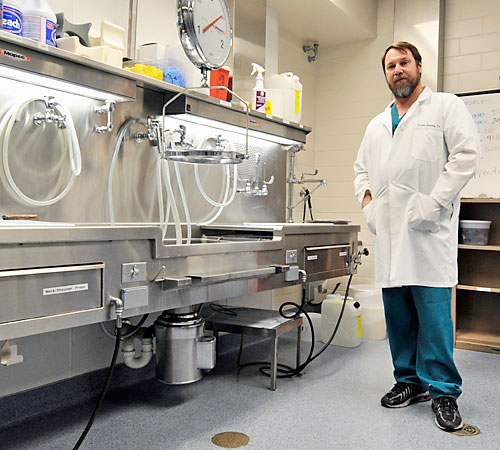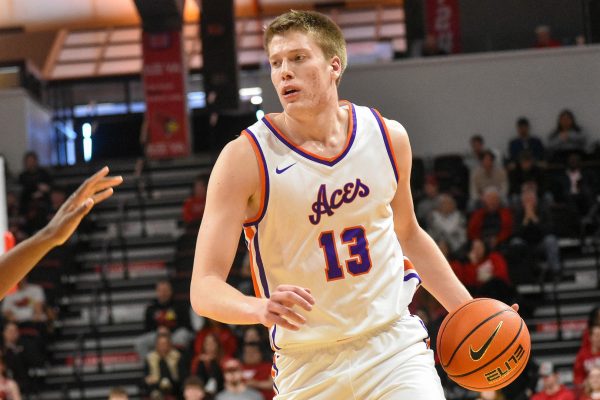The life of an autopsy worker

Charles Embrey, pathological assistant, stands in the morgue at Carle Hospital, 611 W. Park St, Urbana. Embrey started his career with the Armed Forces, and now works at Carle Clinic, performing autopsies and analyzing organs and tissues from patients aft Taylor Johnson
October 15, 2008
Whether it’s examining a cancerous colon or standing over a 600 pound body on a step stool, Charles Embrey is prepared for some strange sights in his line of work.
For the past eight years, Embrey has been a pathological assistant at Carle Clinic Association in Urbana. The main part of his job consists of examining tissues and organs from patients after surgery.
However, he also takes time from his surgical cuttings to handle autopsies.
“I stopped counting how many I had done at 2,000,” Embrey said.
Embrey first began autopsy work through his involvement in the armed forces. He entered the Air Force at age 18 and became interested in the histology field, which is the study of tissues.
Get The Daily Illini in your inbox!
Embrey completed the schooling necessary to become a pathological assistant at the Armed Forces Institute of Pathology in Washington. Because of his interest in the field, he took a three year tour in Europe as an armed forces forensics examiner.
“You’ve never actually seen things until you’ve seen someone run over by a tank,” Embrey said.
What Embrey has to look at can be very demanding. While working with the armed forces, he once had to open a body bag filled with three legs after an airplane crash. However, Embrey has had to work with some cases that are even more disturbing.
“The most upsetting are the child abuse cases,” Embrey said. “The only satisfaction that I get is in knowing that I help put someone away for a very long time.”
Besides the emotionally trying work, Embrey also has to overcome the physically exhausting parts of his job. Some of the cases he handles involve patients who weigh between 600 to 800 pounds.
“I need to stand on a stool to work on them,” Embrey said. “They sit so high on the table it is hard to dig through the body fat and get to the internal organs.”
Most days, Embrey does not have to perform any autopsies. At Carle, there are normally between 20 and 40 autopsies done each year, Embrey said. Hospitals used to do a lot more, but because of advances in technology, hospitals have gotten better at figuring out what is wrong with a patient right when they arrive at the hospital.
“Now when we lose a patient, we have a pretty good idea of what’s going on,” Embrey said. “It’s rare to find something in an autopsy that is unexpected.”
Autopsies are not always performed the same way. Embrey said that there are three different kinds of autopsies: Restrictive, where only a specific area of the body is examined; Unlimited, meaning all the organs and systems can be inspected; and Forensics, which happens in the case of an unexplained death and anything can be examined.
No matter what type of autopsy it is, Embrey follows a specific procedure each time. The exam always begins with reviewing the chart to be sure he knows what he is looking at, followed by the external then internal exam.
“We do a head to toe visual exam to check for scars and marks,” Embrey said. “Then the internal is performed according to the restrictions, and we look at the organ systems.”
While performing the autopsy, Embrey has help from autopsy assistants,like Tom Morrison. Morrison has been working at Carle for about 10 months and mostly works in the lab, but assists Embrey with autopsy work when necessary.
“I help get the body ready, make sure we get the eye color right, clean the utensils and get the tools in place,” Morrison said.
After Embrey begins the autopsy, Morrison helps with tasks such as weighing organs and recording weights and measurements.
“Sometimes I have to lift up organs and move things out of the way,” Morrison said.
When the procedure is over, Morrison helps with the clean up, which consists of sewing the body up and putting it back into the refrigerator.
Besides working with autopsy assistants, Embrey also works with the pathologist, Dr. Bradley Morgan, who has been working at Carle since 1991. After Morgan and Embrey look at the charts for a patient, Embrey and his assistants do the autopsy and consult Morgan if they have any questions.
“If Chuck has any questions, I go down and look at it, especially if it is a medical or legal issue,” Morgan said. “Otherwise, Chuck does it himself and conveys the findings.”
After Embrey composes his gross report of all his findings for an autopsy, Morgan gets the slides and finalizes the reports about the autopsy.
Pathologists also determine how long to wait before performing an autopsy. Embrey said there are some pathologists who would wait for an entire day to be certain the patient is no longer alive. A pathologist Embrey knows at another hospital once had a problem with a patient who attempted to overdose on medicine.
“He sent me an e-mail that said, ‘Got a live one,'” Embrey said. “Right before they started, they realized the patient had a faint heartbeat.”
Although there is not much of it, Embrey does have some down time. When he wants to unwind, he writes medieval fantasy novels, such as his book “The Lost Keep of Kaywall” which he has had published.
No matter what kind of day on the job it is, Embrey finds satisfaction in his work. It is incredible how much punishment the body can absorb, Embrey said.
“The most amazing thing is gaining an understanding of how well we’re made,” Embrey said. “We are phenomenally created.”






